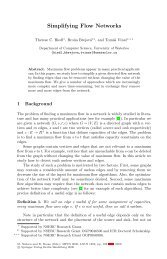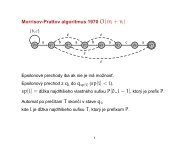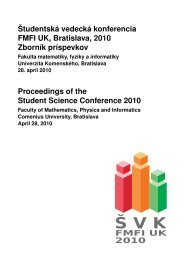1 The Junction Tree Algorithm (Hugin algorithm) Chapter 16(17 ...
1 The Junction Tree Algorithm (Hugin algorithm) Chapter 16(17 ...
1 The Junction Tree Algorithm (Hugin algorithm) Chapter 16(17 ...
You also want an ePaper? Increase the reach of your titles
YUMPU automatically turns print PDFs into web optimized ePapers that Google loves.
Proof. <strong>The</strong> first property was proved in the last class. <strong>The</strong> second property clearly holds from<br />
definition of φ ∗ S and ψ∗ U .<br />
<br />
ψ<br />
W \S<br />
∗ W = φ<br />
W \S<br />
∗ S<br />
ψW<br />
φS<br />
= φ∗ <br />
S<br />
ψW<br />
φS<br />
W \S<br />
= φ∗S φS<br />
φS<br />
= φ ∗ S<br />
Corollary 1. After UPDATE(U,W) and UPDATE(W,U) the local consistency holds for U and<br />
W.<br />
Message-passing protocol. How to do UPDATE’s in a junction tree with more than 2 vertices?<br />
Root the tree in an arbitrary node, then first send messages from the leaves towards the root and<br />
then from the root back towards the leaves.<br />
function Main:<br />
CollectEvidence(root)<br />
DistributeEvidence(root)<br />
function CollectEvidence(node W)<br />
for each child U of node<br />
CollectEvidence(U)<br />
Update(U, W)<br />
function DistributeEvidence(node W)<br />
for each child U of node<br />
Update(W, U)<br />
CollectEvidence(U)<br />
It is easy to see that if U is a child of W and S is their separator, then after CollectEvidence(W)<br />
finishes, <br />
U\S ψ∗ U = φ∗S . Recursion then continues in other parts of the tree, but they do not change<br />
U nor S, therefore this holds until we execute DistributeEvidence(W). At this point part 3 of the<br />
lemma applies and therefore after UPDATE(W,U) both U and W will marginalize correctly. Since<br />
that point we will not change neither U nor W.<br />
1.4 Final proof: If local consistence holds in a junction tree then local functions<br />
are marginal probabilities (s. <strong>16</strong>.7)<br />
<strong>The</strong>orem 1. Let probability p(x) be represented by the clique potentials ψC and separator potential<br />
φS. <strong>The</strong>n if the local consistence holds for each edge in the juction tree, then clique and separator<br />
3









